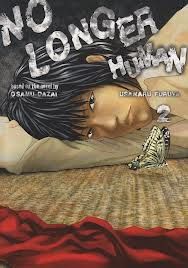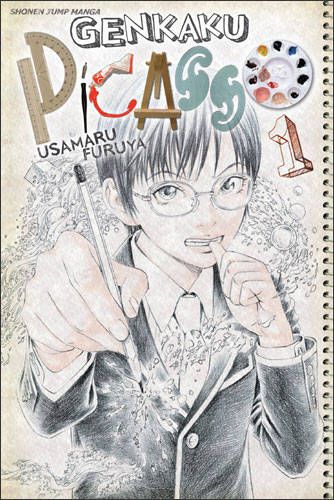Whenever I open a book by Usamaru Furuya, it's tough to tell what I'm going to see. Furuya studied fine art in college, and went on to draw 4-panel strips (a work called Palepoli) for underground magazine Garo without knowing much at all about comics. The results have to be seen to be believed. He's an artistic chameleon, mimicking every style from Botticelli to Osamu Tezuka, with creepy photorealistic portraits of Samuel L Jackson and John Travolta thrown in for good measure. Palepoli's strips are full of violent, sexual, and absurdist humor, with commentary on both Japanese and American pop culture mixed through the whole book. We've only seen a handful of strips from Palepoli in English (in Secret Comics Japan), but his other work can be just as artistically interesting. His habit of changing styles and mimicking the work of others is something you don't often see in manga. He can also change story styles abruptly, from a tween coming-of-age story to a dark adaptation of Dazai's No Longer Human. The three works I mention below were all released in 2011 (a good year for Furuya fans!), but you might also look into Short Cuts, a 2-volume series of 4-panel gag strips, mostly about teenage girls.
Lychee Light Club (1 volume)
Here, Furuya takes a page from Suehiro Maruo. Both the story and art are reminiscent of Maruo's style, who is known for his elaborate erotic-grotesque imagery and 1920s aesthetic. In fact, the story is partially based on a play performed by the Tokyo Grand Guignol theatre troop, where Maruo was one of the actors, and it was this play that inspired Furuya to become an artist. This book follows a group of schoolboys in a club, the purpose of which is to build a robot, powered by lychee fruit, that abducts beautiful women. As you can imagine, this goes all kinds of disturbing places (most of which are depicted with overt fetishism), but it's hard to peg down the thrust of the story from chapter to chapter. Some of the chapters are about the girls they abduct and what happens to them, but most of them are about the relationships between the boys. The characters are quite literally insane, and the club activity begins to shift depending on who trusts who and what they plan on doing to the other members. Zera, the club leader, eventually starts eliminating the others, some of whom worship the ground he walks on. There's a lot of ugliness here, with messy deaths, betrayal, overtly sexual content, and some horrifying scenes of people coming unhinged. The play aspect also has an interesting effect on the story, in that the eight members of the club are more archetypes than they are characters with developed personality (this serves to drive the insanity better), and the settings are limited mostly to the clubroom, with some random short scenes elsewhere. The best part is the ending, which is very bloody, very horrifying, a bit sad and noble, and absolutely exquisite. It's a strange, strange book, and very nice to look at, though difficult to read in parts. This is in print and available.
No Longer Human (3 volumes)
Unfortunately, I haven't read the original to compare, but I believe this is a very faithful adaptation of Osamu Dezai's semi-biographical 1948 novel. It's updated somewhat, in that the framing device features Furuya, who finds the story via an internet blog. The main character, Yozo, is the son of a prominent family, but he's never really felt like he has his own personality, he merely acts the way that those around him expect him to act. He completely lacks human empathy, and fills the void with humor, which makes those around him respond to and notice him. Near the end of his high school life, he begins to fill his personality void with paid sex, and his hobbies and the fact he stops going to school cause him to be cast out of his well-to-do family and his only source of money. He begins to live off the means of others, becoming an alcoholic and getting himself involved in several bad-idea relationships. Mostly, it's the story of his depression, its effect on his life, and how it makes him unable to live in and cope with modern society. This was my least favorite of what I've read by Furuya, mostly because I found it's thoroughly dark and bleak nature difficult to read, but it's still an interesting story. Initially, I thought that Furuya's artistic gifts might be wasted on a work like this, but he still has a lot of fun with it. The narration segments that feature him are drawn in a very utilitarian style unlike the main story, and he periodically uses exaggeration and surrealism to depict Yozo's mental illness, how he perceives himself, and the very worst of his depression. It's an excellent adaptation of a very famous work of literature, and all three volumes should be currently in print and available.
Genkaku Picasso (3 volumes)
There's a lot of books by Furuya that I would love to read, as he does a lot of fantastic conceptual stories. They haven't been translated into English for various reasons (I suspect many of them are too erotic, violent, or disturbing). But of what we have in English, this is my very favorite. It's the story of grouchy, misanthropic high school student Hikari, who actively shuns his classmates in favor of constantly drawing. Chiaki is the only one who isn't deterred by his wish to be alone, and she always winds up hanging around with him despite Hikari's best efforts to drive her away. Tragically, both of them are struck by a falling helicopter and killed, but because Chiaki prays hard enough, Hikari survives. The catch is that he must now help people, or his body begins to rot and he will die the death he was meant to have (this is to counterbalance the fact that he really, really doesn't want to do this). Chiaki hangs around in the form of a little fairy, a kind of Jiminy Cricket conscience that tells Hikari how to help people. Since Hikari's observation skills would be useless for spotting someone wrestling with a problem, when his help is needed he suddenly gets an overpowering urge to draw a very detailed, surreal pencil sketch in his notebook that somehow represents a problem that one of his classmate is currently suffering from. Hikari, completely lacking any social skills, will ask questions like "Have you had an abortion recently?" or "Are you into S&M?", which often earns him the cold shoulder. But when he does enough nosing around, he and Chiaki enter the pencil sketch and do battle in the surreal, pencil landscape of the classmate's subconscious. At the end, the classmate usually winds up thanking Hikari and befriending him, which Hikari wants no part of. There are several chapters like this (the chapters are very long), and after he's gained several new friends, the grand finale is that Hikari himself may need some help. There are hints of this throughout the story, and I adore twist endings that are laid out far in advance like that. Aside from the fact that Hikari makes for a great shounen manga character (again, he's cranky and misanthropic, which is a far cry from the usual gallant hero willing to make friends), the best part of this story really is Hikari's drawings. They're drawn in pencil, and the scenes where he enters them and solves the problems are rendered in a similar surreal pencil style. It's quite amazing, and I enjoyed it immensely given that it's an otherwise fairly standard story about making friends. Interestingly, Furuya also mentions that Hikari was basically himself in high school, which is fun to imagine. All three volumes of this series should be in print and available.




